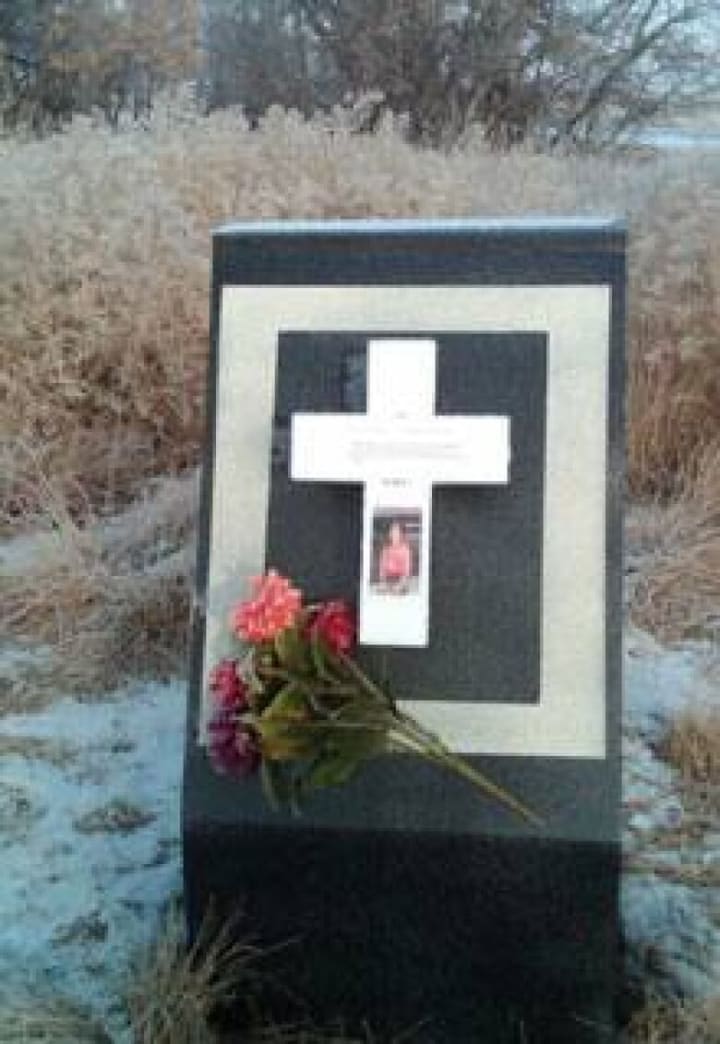They Told Me Small Town Were Peaceful
A local perspective on the murder of Carol King

They told me small towns were peaceful. It was understood that we country bumpkins should be neighbourly and welcoming. They never warned me of the darkness lurking down dusty back roads.
Herschel Saskatchewan is a minuscule village featuring a quaint museum of local history, and not much else to speak of. I would often traipse about town with friends, or laze around the eternally unlocked community centre on quiet weekends. Okay, you got me; it was a hockey rink. Unbenounced to us, that “peaceful” village teetered on the precipice of tragedy.
I had existed quietly in the neighbouring township of Rosetown Saskatchewan for only a few years when our community was thrust into fear and uncertainty. Carol King disappeared from her home in Herschel Saskatchewan on August 6th, 2011. She was reported missing by her sister after several unsuccessful attempts to contact her. This was highly unusual as Carol always carried her cell phone. RCMP Air Services discovered her abandoned car four days later, almost completely submerged in a nearby slough (like a bog or musty pond). Carol was nowhere to be found.
A general sense of unease quickly settled over us. Everyone was a suspect. What had become of Carol King? Were we next? Who do we trust as the safety of our cocoon shatters around us?
As the days dragged on a blanket of darkness descended upon our dispersed community. Tales of stalking and harassment prior to Carol's disappearance whispered through the shadows. It felt inconceivable that one of our own could be capable of such malice.
Word spread that Carol had been due to meet with Rosetown RCMP the day of her disappearance. She was to be recording a video statement in relation to an ongoing harassment case against her ex-partner Joseph “David” Caissie. Due to the nature of the statement, Caissie would have been informed of the impending appointment prior to Carol's disappearance. We had our first real suspect, but the situation was becoming unbearably bleak. Our hope of finding Carol alive diminished by the day.
Three weeks after the disappearance of Carol King, search parties set out across the vast expanse of prairie. Several members of my then-boyfriend's family participated as first responders. Their family comprised nearly half of Rosetowns volunteer fire department at the time. In the late hours of August 27th, we got the news. A shaking voice uttered the words we had been dreading. A member of the family had located Carol King's remains on the abandoned property of their family farm. The disappearance of Carol King was officially ruled a homicide.
Shortly after 9 am on December 18th, 2011, I was jolted awake by the blaring alarm of a fire department pager. My boyfriend flew out of bed as his father shouted down the stairs to meet in the truck. When they finally trudged back in hours later, I learned of the latest development in Carol's case. A fire had broken out in what should have been the empty home of Carol King. The blaze had destroyed much of the home, along with potential evidence. Though the sudden inferno was suspected to be arson, no charges were ever laid. I believe by this point we all have a suspicion about who the elusive culprit may have been.
The Story Emerges
Carol's Mother, Yvonne King, told CBC News in 2011 that she and her family were concerned for Carol's safety in the weeks leading up to her disappearance. Carol had relayed several accounts of suspicious nighttime activity outside her home. She noticed what appeared to be two men prowling around the property under cover of night. Carol reported a similar occurrence to police the night before her disappearance.
"There was a man, the shape of a man bent down by the trees," Yvonne King told CBC News. "And she chased him with her flashlight and said, 'Get off my property.'"
Joseph Caissie lived with his wife and children on a neighbouring property, easily within walking distance of Carol's home. He could have snuck onto her property at any time with little to no effort. But who was this mysterious second figure? Did Caissie perhaps have an accomplice?
Carol reported this final account to local RCMP officers and was given an appointment to meet with them the following afternoon. It is my understanding that the handling of Carol's situation by local authorities was negligent at best. Every effort was made to find the killer after her remains were discovered, but where was that voracious pursuit of justice while she could have been saved?
One of Carol's sisters posted comments on Facebook, purportedly from Carol herself, expressing frustration with RCMP’s handling of her complaints.
According to the sister, King wrote: "Holy crap, if he ever decided he wanted to hurt me, I'd be dead before the cops responded."
A friend of Carol's, who wished remain nameless, spoke to CBC News:
"She was always hiding out from him," the friend stated. "She had said that he would come around her home late at night. And she always heard rustling around outside and whatnot. He only lived one property over."
In 2011 Caissie stated in a CBC News interview that these allegations were not true, Carol had never been afraid of him.
Joseph Caissie was previously sentenced to five years in prison for a violent sexual assault perpetrated in 1998. When CBC News asked him about the conviction he reportedly responded, "What's that got to do with anything?"
The Mysterious Memorial

After the discovery of Carol's body, a mysterious memorial appeared on the site of her death. A headstone, makeshift cross, flowers and cryptic message appeared, seemingly out of nowhere. The message read:
"Please don't give him your HATE, he's not WORTH it. The Lord he cam [sic] and got me, and took me far away. Remember, I wasn't in my body when the DEVIL came to play. WHY?"
For years no explanation surfaced regarding who created this strange memorial or why. Was this a message from her killer or simply a misguided attempt to commemorate the loss of a community member?
It would later be revealed in court that RCMP officers had planted the memorial. It was laced with hidden surveillance equipment, monitoring the site for any suspicious activity.
The Mr. Big Sting
“Mr. Big” is an undercover investigation technique developed by British Columbia RCMP officers in the early 1990s. This sting operation is sometimes referred to as the "Canadian technique". It is considered a last resort to elicit a confession from suspects in cold cases (usually murder) where they have a strong suspect but insufficient evidence to convict.
During this operation, undercover police secretly record as they lead suspects to believe they are being groomed for membership in a fictitious “grey area” or criminal organization. The undercover officers build trust with a suspect by offering them something they need, such as employment. The target is offered progressively more illicit opportunities, for which they are paid. This aligns their confidence and allegiance with the fictional organization.
A suspect's eventual goal is to gain their new cohorts' trust, inching ever closer to a big payday and the organization's leader, “Mr. Big”. Once the suspect becomes enmeshed in criminal activity their “partners” persuade them to divulge information about their criminal history. Complete honesty and translucence of anything that could “endanger the organization” is proffered as a prerequisite for full initiation. If a person is innocent, the belief is, they won’t have anything to confess.
The “Mr.Big” technique is notoriously controversial. It has been accused of eliciting false confessions, among other ethical dilemmas. Court officials allege that suspects may falsely confess, feeling it necessary in order to gain clout or continued acceptance in the fictitious crime ring.
Carol King's case had run cold four years prior to the launch of RCMPs sting operation. After rigorous planning, and 5 long years of injustice, the investigation that would break Carol’s case wide open was underway. The “Mr. Big” sting took only 5 months to amass damning amounts of evidence against Caissie.
In February 2016, undercover officers approached Caissie's wife at their new home in Alberta. They posed as door-to-door solicitors offering her a chance at a sweepstakes VIP package. Caissie's wife originally refused the offer but allowed the women to come inside and use her restroom. With a bit of quick thinking, an officer left her phone behind and the pair exited the home. After returning later for the phone, officers were able to persuade the woman to enter their contest. The following week she received the “exciting” news, they had won! The Caissies were picked up by a limo containing two other “winning couples”, played by undercover police.
The officers chatted up Caissie and began to build a relationship by hiring him for a small job. Knowing he was a construction worker by trade, they offered him a few simple contracts. The line had been baited and Caissie was hooked. It was time to start luring in the big fish.
Officers began dangling projects of a progressively illicit nature. This slowly woven web tested Caissie's commitment to the fictional organization. As he became comfortable with the officers Caissie opened up about his relationship with Carol. He told officers about the house they purchased together and his fear that she was planning to take it from him. He explained that, in his belief, she was upset that he had gone back to his wife and may have been planning to make a false sexual assault report against him. This would have landed him in jail, leaving her the sole owner of the property. Carol had hoped to sell the property before moving back home to Nova Scotia.
The confessions gradually escalated as weeks elapsed. On several occasions, Joseph Caissie confessed to undercover police that he had, in fact, murdered Carol King. The single discrepancy in his tale was the murder method. Caissie originally lied to the officers, later explaining the true method and claiming his earlier transgression was due to suspicions of being “set-up”. He described the events to officers in sickening detail from premeditation to completion. The intense determination, devoid of remorse, that Caissie expressed while attempting to convince officers of his claim was chilling.
Caissie was even so bold as to show officers every location as he wove his sickening tale of kidnapping and malice. He seemed almost proud of his heinous crime, showing off trophies and telling the story casually as though it had been your average hunting trip. Everything he said was corroborated by evidence, some of which had not been made public. This fact was essential in the judge's final ruling on whether the sting operations results would be admissible in court.
The Capture Of A Killer
During their initial investigation police reported that they questioned Cassie but he was not a suspect at that time. In December 2011, Caissie declared his innocence in an interview with CBC.
“I want them to find out who did this ... so that people will know that I had nothing to do with it," Caissie said at the time.
-Reporter Geo Leo’s exclusive interview with David Caissie.
Not exactly the impassioned plea of a grieving man.
On July 19, 2016, following the controversial “Mr. Big” sting operation, Caissie was arrested for Carol King's murder. He was charged with first-degree murder and offering indignity to human remains. It would be another 4 years before the court made its final ruling.
Before a trial could begin the judge had to decide if the evidence provided by RCMP’s sting operation would be admissible in the proceedings. Justice Richard Danyliuk heard all this evidence during several week-long voir dires. This process was spread over a four-month period before the decision was made. After much deliberation, it was ruled that the evidence met requirements and the Mr. Big sting would be admissible. That evidence would become the bulk of the trial as Caissies tangled web quickly unravelled.
His trial took place in Saskatoon Court of Queen’s Bench in 2018, two years after his arrest. Cassie chose to be tried by a judge alone. Citizens of Canada who are charged with an indictable offence may choose to be tried by a judge alone or with a jury.
As expected, Caissie pled not guilty. The lengthy uphill battle for justice was officially underway.
Brenda King appeared in court, via video, from the east coast to be questioned by both the Crown and defence about the nefarious events prior to Carol's death.
The devastated sister relayed a chilling tale of her visit to Herschel in July 2011. During the visit, Brenda told the court, Carol had received a letter at the local post office from Caissie stating his intention to place a lien against her property.
Brenda told the court she had witnessed the two arguing on the phone, then later in person, over the notice. She testified that she had reviewed the contents of the letter sent to Carol and things quickly escalated from there.
Brenda recounted the night of July 19, 2011. Caissie had parked his truck under cover of nearby bushes around midnight. He proceeded to search the property for two hours with a flashlight as the sisters hid inside. This incident led Carol to finally file an official report against Caissie, fearing for her life. Brenda also reported instances of Caissie driving slowly past Carol’s home, which was only two kilometres from the house he shared with his wife and children.
His stalking was relentless and nearly unhindered by local law enforcement. She had reached her limit and planned to leave Herschel in the coming months. Carol had been arranging to return home to Nova Scotia in November, at the end of her current employment contract. Regrettably, that day never arrived. Brenda expressed deep regret over not convincing her sister to come home with her in July. That visit would be the last time Brenda saw Carol alive.
One of the men who participated in Caissie's plot came forth at trial, answering one of our biggest questions. Who had invaded Carol's property and what were they doing skulking around her home? The witness revealed that Caissie had paid the men one hundred dollars each to harass Carol repeatedly while he was away on work. His intention was to instill fear and create suspicion that someone else may be after Carol, alleviating the suspicion drawn on himself.
The defence called only one witness – an employee of the motel in Olds Alberta where Caissie had stayed during his work trip slash alibi.
The woman claimed she saw Caissie walk by the front desk around 5 p.m. on Aug. 6, 2011. If this were true, it would prove that Caissie couldn’t have been in Herschel, at the time of Carol's death.
The testimony fell apart in cross-examination. The flustered and confused employee recanted her statement, confessing that she didn’t know for sure if she was recalling the right date.
The conviction
During closing arguments, all focus zeroed in on one debatable detail of the case: the timeline.
Though Caissie has previously claimed he was in Old Alberta at the time of Carol's disappearance, evidence proved otherwise. Though he provided a camera that held a time-stamped image proving he was in Olds at 9 pm, the majority of his day was unaccounted for. RCMP revealed that Caissie had received a speeding ticket near Hanna, Alberta around noon that day. After receiving his ticket Caissie continued travelling east, toward Herschel. The Crown argued that with this evidence, and at the rate Caissie had been travelling, it was entirely conceivable that he could make the drive to Herschel and return to Olds within the timeline.
With the insurmountable pile of evidence against him, Joseph “David” Caissie was convicted of first-degree murder and given the mandatory sentence of life with no chance of parole. Carol's loved ones finally had justice for their tragic loss, a small comfort in the wake of unimaginable grief.
Carol Nora King will never be forgotten. Her story will be known.

Sources:
https://www.cbc.ca/news/canada/saskatchewan/mysterious-memorial-appears-for-carol-king-1.1045121
https://leaderpost.com/news/crime/shes-gone-episode-3-the-disappearance-and-death-of-carol-king-part-2/wcm/feb95ca2-53e8-4583-907e-7c5974f00f57
https://www.cbc.ca/news/canada/saskatchewan/dead-woman-feared-for-her-safety-family-says-1.997788
https://www.google.ca/amp/s/www.cbc.ca/amp/1.3686500
https://regina.ctvnews.ca/mobile/fire-at-carol-king-s-former-home-being-probed-as-arson-1.742113
https://www.google.ca/amp/s/globalnews.ca/news/4504477/murder-trial-saskatoon-david-caissie-carol-king/amp/
About the Creator
The Creative Chimera
Welcome! I’m an Artist, Twitch streamer, & eclectic writer. I do fiction and non fiction so check out my profile to see more of my topics! I joined vocal to spread some knowledge, share some of my works & find awesome writers to experience!






Comments
There are no comments for this story
Be the first to respond and start the conversation.